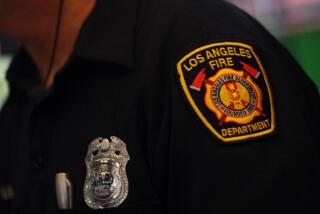Road to Buying a Used Car Can Be Full of Potholes
- Share via
It is depressing to buy a used car, believe it is in sound condition, only to find out later it has been in an accident or perhaps even “totaled.”
In the latter instance, your new car, in fact, should have been “branded” a salvage vehicle.
Just how often is someone fooled in California, where a survey by the state Bureau of Automotive Repair found that 150,000 salvaged vehicles are returned to the roads every year, not to mention 700,000 that had been structurally damaged?
No one knows what percentage of the “totaled” cars fail to carry the salvage label. In too many cases, the title is “washed,” sometimes by transferring it through other states.
The numbers 150,000 and 700,000 seem high, until one learns that this state has 27.4 million registered vehicles.
Repaired automobiles are an important part of the total picture: Only a tiny number of the 150,000 “totaled” vehicles, after being rebuilt, have been inspected. A sizable number may be unsafe. And even when the title includes the salvage brand, many buyers notice it only belatedly because the title initially is sent to the finance company, which holds it until the car is paid off.
I recently went to an auction of about 200 wrecked cars at the Gardena branch of Insurance Auto Auctions Inc. Most sold for a few hundred dollars, and many seemed in such bad condition that I was sure they could never be repaired.
But, I was told by Jim Gaye and Terry Fiskin of the Auto Dismantlers Assn. of Southern California, who accompanied me, that even such cars have uses other than providing spare parts.
They said an undamaged front end can be joined to an undamaged rear end and the “repaired” vehicle resold. (I wouldn’t like to drive that car around the city.)
Or, they said, a vehicle identification number (VIN) could be removed and used to replace the VIN of a stolen vehicle to conceal its true origin.
About 50% of the buyers at the auction will, in handling these wrecks, be engaged in something illegal, Gaye and Fiskin asserted.
The auctioneer has a warning sign posted: “On a weekly basis, IAA reports every sale, including the identity of the purchaser, to the National Insurance Crime Bureau. . . . When available, [we] include picture ID of buyers.”
But Marcia McAllister, corporate counsel for Insurance Auto Auctions, said that to suggest that half of all the buyers are crooked is too high.
“Anybody can have some customers that are not law-abiding, but it’s nowhere near these numbers,” she said.
As is so often true, a lawsuit may clarify consumer rights issues.
Looking, I found Jennifer Galanza vs. Barber Pontiac of Bakersfield, due for trial in May.
Galanza, who lives outside Fresno, bought a 1993 Honda del Sol with 32,000 miles from Barber’s Honda subsidiary when she was 21 in 1995.
“This is my first investment and my first debt,” she explained. “I called all the Honda dealers within two or three hours driving, saying I was looking for a red Honda del Sol, wanted it in good condition, a trade-in or just a buyback.”
Soon, she got a call from a salesman for the Bakersfield dealer, saying it had just the car. “He told me it was a trade-in that he received that day. Right after work, I drove to Bakersfield.”
Galanza said she and a male friend who accompanied her “asked every single question we could ask. . . . The salesman said it had never been wrecked. It was a trade-in because the past owners needed something larger.”
But after she purchased the car and began $275 monthly payments, Galanza said it was veering to the right. Taking it to a repair shop, she was told it had a 1995 hood, two years newer than her car.
When she asked the Barber salesman, she said he gave her increasingly unbelievable explanations for the new hood.
“I took my car into a collision center for them to look at and tell me exactly what was wrong. They told me that just by looking at it, they could tell the whole front right end had been wrecked.”
When Galanza got a DMV report to find out who the prior owner had actually been, she found that the car had belonged to an L.A. woman who had an accident resulting in $10,000 in damage.
Galanza’s attorney, William Krieg, told me that records showed that in a short time, the car had passed through five different hands, including auto salvage firms, private rebuilders and finally the Barber dealership.
The insurance company that dealt with the original owner never did send salvage information to the DMV because it had no original intent to salvage it, he said.
Galanza is suing all those but the insurer who had possession of the car after the accident. She continues to drive the car and make payments because she feels she has no choice, and the car now has 106,000 miles on the odometer.
Stephen Ekegren, vice president of Barber, said he felt “uncomfortable” discussing the matter because it was in litigation. “I don’t feel I should jump into the muck and the mire,” he said.
But, he added, Galanza has made some claims that are “not correct.”
“We’ve been in business for 43 years,” Ekegren said. “This is the only time this issue has come up.
“Mechanically, the car appears to be sound. It has no cosmetic defect. She’s been driving it.”
As for the repairs, Ekegren observed, “it appears that a lot of times a repair is done so well that a dealer is just not aware that it has had previous damage.”
But Galanza remains determined. Not only was she lied to about the trade-in, she said, but she fears that if she did have an accident, the car would not fare as well as it would if it had not sustained prior damage.
“I wouldn’t have bought the car if I had been told it had been wrecked,” she said.
How many Californians would?
*
Ken Reich can be contacted with your accounts of true consumer adventure at (213) 237-7060, or by e-mail at: ken.reich@latimes.com






